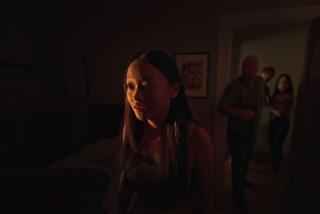Horror in a strong and steady ‘Pulse’
- Share via
Which is scarier -- knowing you are going to die, or the threat of immortal solitude? In Kiyoshi Kurosawa’s “Pulse,” Tokyo is a ghost city of lonely people living in tiny, cell-like apartments, so that all their possessions lie within reach, but human interactions require technology. As ghostly images start to appear on computer screens, people begin to vanish. A dreamlike, insidiously eerie meditation on death as eternal loneliness -- or is it loneliness as living death? -- “Pulse” imagines the apocalypse as the slow, barely perceptible siphoning away of life, the logical endgame of technology-assisted alienation. A whimper.
When Taguchi (Kenji Mizuhashi), a young computer technician, fails to deliver a disc to the Sunny Plant Sales nursery and doesn’t return calls, his friend Michi (Kumiko Aso) goes looking for him. Finding him in his dark and cluttered apartment, seemingly fine but oddly remote, Michi rummages around for the disc while Taguchi hangs himself in an adjoining room, leaving a mysterious stain on the wall.
Soon, Michi and her friends Junko (Kurume Arisaka) and Yabe (Masatoshi Matsuo) begin receiving mysterious cellphone calls. Ghost images appear on their computer screens, and sealed doors to hidden rooms beckon. The mystery compounds, meanders and replicates, but Yabe’s theory is as close to the film comes to an explanation: As the realm of the dead became overcrowded, ghosts searched for a portal into the world of the living. Now ghosts spread virally through the Internet, turning those who come into contact with them into aimless, isolated phantoms.
Meanwhile, an economics student, Kawashima (Haruhiko Kato), logs on to the Internet for the first time and finds himself suddenly confronted by ghostly images of ghostly suicides. Searching for an explanation, he goes to his university’s computer lab and meets Harue (Koyuki), a young woman who offers to help.
The movie takes place during a record-breaking heat wave, and the Tokyo of Kurosawa (no relation to Akira) appears hushed, desolate and shrouded in fog. Although the characters live alone in cramped interiors that suggest overcrowding and claustrophobia, the city is increasingly desolate. Junko and Harue, both pretty and vivacious on the surface, exude a plaintive loneliness, whereas Michi and Kawashima seem to have adapted to their environment by asking little from life. At first it seems strange that Kawashima is logging on to the Internet for the first time in his mid-20s, but then it becomes clear that the promise of mediated connection doesn’t interest him. Harue, on the other hand, lives in an environment dominated by screens, and she’s completely sealed off within herself and unreachable.
Different as they are, the movie reminded me of the excellent “28 Days Later,” another horror allegory about 21st century malaise manifested as infectious plague. Here, it’s anomie, not rage, that does people in. So the story unfurls like a creeping nightmare, rather than an attack. Neither linear nor overly explained, “Pulse” completely dispenses with smash cuts, cymbal crashes and other editing tricks of the horror trade. The art direction is so simple as to seem nonexistent. There’s something nakedly plain about the characters’ lives, as though they’ve been denied the comfort of adornment. The camera trains its unblinking eye on quietly unnerving scenes and forces us to watch until they become unbearable. Actually, I say that, but I closed my eyes toward the end of the scene where Yabe gets cornered by a ghost. The ghost looks like a lady, but moves like the Merce Cunningham of the crab kingdom. In another unnerving moment, a jetliner tears through a single corner of the screen and drops from the sky without fanfare. What’s scary is not that it crashes, it’s that by then the crash doesn’t matter. The world is too far gone to register individual tragedies.
“Pulse,” which sat on Miramax’s shelves for four years before Magnolia Pictures obtained theatrical rights, arrives shortly before its remake, also called “Pulse,” co-written by Wes Craven. Judging by the trailer, the American version promises to be the young adult version of “White Noise,” and it seems reasonable to expect that phenomena will be explained, ghosts will be sent packing and the world will again be safe for random hookups. Are kids really so prosaic now? Somehow, I doubt it -- especially as Kurosawa’s “Pulse” captures the anomie and depravation of early adulthood with such bone-chilling accuracy. You hate to call a ghost movie haunting, but there it is. It sticks around and rattles.
*
‘Pulse’
MPAA rating: Not rated
Times guidelines: Contains frightening scenes of supernatural horror and suicide
A Magnolia Pictures release. Written and directed by Kiyoshi Kurosawa. Produced by Shun Shimuzu, Seiji Okuda, Takeshi Inoue, Atsuyuki Shimoda. Director of photography Junichiro Hayashi. Editor Jyunichi Kikuchi. Music by Takeshi Haketa. Running time 1 hour, 50 minutes.
Exclusively at the Nuart.
More to Read
Only good movies
Get the Indie Focus newsletter, Mark Olsen's weekly guide to the world of cinema.
You may occasionally receive promotional content from the Los Angeles Times.










